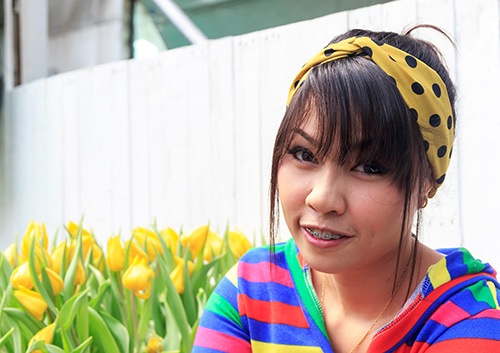April 3rd, 2018

Now that you are working hard to improve your dental health and appearance with your braces, it might seem like a logical time to whiten your teeth as well. But should you go ahead with home kits or a professional whitening? The answer might be yes, but not quite yet!
Toothpaste
The easiest way to whiten teeth is regular use of a whitening toothpaste. But these do not make a major difference in tooth color and may also contain abrasives which can damage ceramic brackets and make them more likely to stain. And, whether you have metal or ceramic braces, the brackets used are bonded to your teeth. Any part of your tooth covered by a bracket will not be affected by the whitening paste. Ask our office if you are thinking of using one of these products. We will be happy to recommend the best toothpastes to use while your braces are in place.
Whitening Strips and Trays
Whiteners can be applied at home with strips or tray kits. Strips are coated with a whitening gel and then pressed around your teeth. Tray kits provide a mouthguard-like appliance, which is filled with whitening gel. But neither strips nor tray solutions will whiten any area covered by brackets. When your braces come off, there might be noticeable differences in color on each tooth. Strips are difficult to apply with braces, and trays need to be custom-designed to fit your braces and make sure they don’t disturb your orthodontic work. One size most definitely does not fit all! Finally, these whitening agents can cause tooth and gum sensitivity, especially around the time of adjustments. Many manufacturers do not recommend using their products while you have braces. Please talk to us if you are thinking of using them.
Professional Whitening
A dental professional can whiten your teeth in office for the best possible results. The most effective treatments for your unique teeth are combined with protective care of your gums and mouth. Whether this treatment is appropriate while you have braces is something we are happy to discuss.
The best way to keep your teeth bright is to keep up your regular dental routine! Brushing and flossing are more important than ever now, because plaque builds up around brackets. Avoid foods that stain teeth and rinse or brush after every meal and snack. Dr. Byron Diehl will show you the best way to take care of your teeth while your braces are on—and that includes the best way to keep them white and bright. Talk to us about the perfect time to whiten your beautiful smile during your next visit to our Redlands, CA office. And if you have to wait a few extra days for the smile you’ve been working toward, truly, the wait will be worth it!
March 27th, 2018

If you’ve never been to an orthodontist before, you might be wary of what to expect during your first visit. Your dentist may have recommended an orthodontic appliance if it could improve the state of your oral health. More often, you may suspect that you or your child should have orthodontic work done if the time is right financially.
Understanding the various options your orthodontist can perform will be helpful to know before your appointment.
Your initial appointment usually lasts at least an hour. It’s common that diagnostic work will need to be done. This might include getting X-rays so Dr. Byron Diehl can better understand the overall structure of your mouth. A quick mold of the mouth may also be taken if braces are a possibility.
Your first appointment is intended to find out how we can efficiently give you a great smile! Here’s a list of common questions you might ask during your first visit:
- Is now the right time for treatment, or should it wait?
- What is the estimated length of time for the treatment?
- How much should I expect to pay? What are the payment options?
- What can I do to prevent or minimize pain?
- Is it likely that I will wear extra appliances in addition to braces to correct my overbite, underbite, or other problems?
- Are there specific foods I will need to avoid?
- Will braces prevent me from playing my favorite sport or musical instrument?
- How can I keep my teeth clean with braces?
- How often will I be expected to come in for checkups and other appointments?
Don’t be afraid to ask these and other questions before you or your child commits to getting braces. Dr. Byron Diehl and our team are happy to answer any of them before or after your visit.
Once you’ve had your initial consultation, our team will be here throughout the entire process if any problems arise. We look forward to seeing you at your first appointment in our Redlands, CA office!
March 20th, 2018

If you’ve visited Diehl Orthodontics, then there’s a good chance you’re looking to perfect your smile by straightening your teeth with braces. At some point during your treatment, you may need to use elastics, otherwise known as rubber bands, for a certain period. These are used to apply additional pressure that will move your teeth in the right direction.
Placement of the elastics is specific to each patient’s teeth. These small rubber bands stretch over the tiny loops on both the top and bottom brackets. At first, Dr. Byron Diehl may recommend you wear the elastics both day and night for an extended time.
You may be told to switch only to nighttime wear once the teeth are set in the correct position. By consistently wearing the elastics, you can shorten the overall time your braces will have to be on.
The elastics are made from medical-grade latex. If you have an allergy to latex, make sure to let Dr. Byron Diehl know, so you can be given an alternate material. We will show you how to take elastics on and off when they’re given to you at your appointment.
You should remove them when you eat so they don’t become overstretched or break. It’s important not to overstretch the bands, and always to replace them if they break. Eventually it will become a familiar habit to carry the bands around with you for times when this might happen.
The Do’s and the Don’ts
- DO … always wash your hands before removing or replacing the rubber bands.
- DO … call us if you run out of elastics.
- DO … get in the habit of carrying around extra rubber bands as replacements.
- DON’T … double up on elastics because this can exert too much pressure on your teeth and could actually harm the roots.
- DON’T … overstretch the rubber bands or they will lose strength and become ineffective.
If you were recently given elastics as well as your braces, feel free to ask any questions during your appointment, or call our Redlands, CA office any time. Using elastics correctly is one more step in your journey to a perfect smile!
March 13th, 2018

When you start wearing braces, it can become a challenge to clean certain areas of your mouth. If these areas are neglected for long periods of time, though, decay and stains can form on your teeth.
Your mouth will require extra attention while you have your braces on. This can include using a special toothbrush to reach those spots, flossing every day, getting fluoride treatments, avoiding certain foods, and making sure to visit your dentist. Let’s take a closer look at what you can do to prevent decay during treatment.
When you get your braces on, Dr. Byron Diehl will give you an interdental toothbrush that can be used to get to those hard-to-reach spots in your mouth. The brush has bristles that can easily remove food residue stuck between the wires in your mouth. We may also suggest using a WaterPik, which pulses a pressurized stream of water to remove excess food particles.
Brushing and flossing every day should always be a part of your oral health regimen, but this becomes especially crucial when you have braces. If food gets stuck between braces and sits on your teeth, decay and staining will start to occur. Dr. Byron Diehl and our team recommend flossing at least once a day, and brushing and using mouthwash after every meal as long as you have braces.
If you don’t have the time, make sure at least to swish your mouth really well with water after you eat. It’s especially important to follow these steps after consuming sugary foods or beverages. It’s best to avoid sweets altogether when you have braces.
Making sure to visit your dentist at least twice a year for a routine cleaning can also help to prevent any decay from damaging your teeth while your teeth are encased in braces. Your dentist will remove any plaque or tartar that’s built up since your last cleaning.
Prevention is key when it comes to keeping your mouth healthy during orthodontic care with braces. Follow these tips and you’ll keep your teeth beautiful and healthy for the day your new smile is finally revealed!





 Website Powered by Sesame 24-7™
Website Powered by Sesame 24-7™